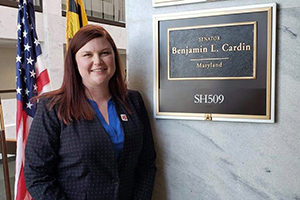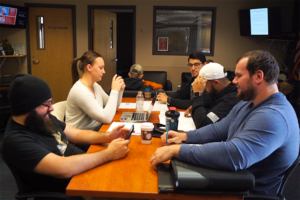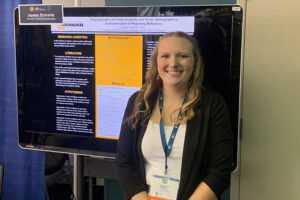When U.S. troops were deployed in Iraq and Afghanistan, they frequently disposed of garbage using burn pits – huge holes where they dumped everything from household trash to medical waste, doused it in jet fuel, and set it alight.
“A lot of these pits were burning 24 hours a day, and they were located on or near the military installations where service members served,” said Rebecca Patterson, a Navy veteran and a UWM alum. “They inhaled this smoke all day long, and there was a lot of bad stuff in there.”
Patterson was especially interested in one particular class of chemicals released in these burn pits: dioxins, the same cancer-causing compounds found in Agent Orange from the Vietnam War era. She made them the topic of one of her final research papers at UWM.
“That was my introduction to environmental exposures in the current war connected to environmental exposures in Vietnam,” Patterson said. “It made me realize that I wanted to study environmental health.”
Now, as the assistant director of the Veterans Health Council, she gets to do just that.
Working for veterans
The Veterans Health Council is a program of the congressionally chartered veteran service organization Vietnam Veterans of America. The council’s goal is to improve health care for veterans by educating service members, veterans, their families and health care professionals about health issues associated with military service.

For Patterson, that means keeping up with the science as information comes out about environmental exposures service members may have faced. The National Academies of Science, Engineering, and Medicine are currently studying health effects from the burn pits, and they’ve recently turned their eyes toward another contaminant.
“They’re starting to look into PFAS, which is a class of chemicals that has contaminated our water supply across the country,” Patterson said. “Several chemicals were, and others remain, a component of the aqueous film-forming foam that the military uses for oil-based fires.”
She is also working on a grant funded by the Wounded Warrior Project that allows the Veterans Health Council to collaborate with other organizations to advocate for service members, veterans and their families affected by toxic exposures. Patterson also conducts training for health care providers so they can learn to better serve their patients with military backgrounds.
The shortcomings of medical care
When most people think about the health issues affecting veterans, their minds jump to combat wounds or PTSD. But limited thinking is a mistake, Patterson warns, and health care providers who work outside of the Department of Veterans Affairs system need to be prepared.
“Less than 20% of military veterans receive all of their health care at the VA. A lot of veterans do not self-identify to their non-VA providers because they don’t understand the significance of the things they’re exposed to; they have no idea of the health effects they can cause,” Patterson said. “The fact that our health care providers are not asking if we’ve ever served in the military means they don’t know how to accurately diagnose and treat us, and that’s a big problem.”
The effects of toxic exposures can vary. For veterans affected by Agent Orange, an herbicide used during the Vietnam War, effects can include cancer, Parkinson’s, diabetes and neuropathy, among many other conditions. The effects of more recent exposures, like the burn pits in Iraq and Afghanistan, aren’t clear yet because it may be years before long-term health consequences manifest.
That presents an additional challenge: When veterans seek care or compensation from the federal government for health conditions, they often have to prove that their condition was caused by an environmental exposure they experienced during their service.
A personal mission
Advocating for service members is a mission near and dear to Patterson because she’s a Navy veteran from a family of Navy vets. Patterson joined up when she was 21 and trained as a Farsi linguist at the Defense Language Institute in California. She was stationed in Georgia and completed a six-month deployment to the Persian Gulf.
When her service ended, Patterson enrolled at UWM, where she majored in chemistry and earned certificates in forensic science and forensic toxicology. While on campus, she found herself drawn to other student veterans.
“The Student Veterans of America chapter at UWM had just started,” Patterson said. “Through those early years, we were able to get the Military and Veterans Resource Center started. Once that was built, I spent a lot of my time there.”
Later, she got involved with UWM’s student association as the veterans advocacy senator. She’s kept up that tradition of advocacy ever since. After graduating, she took an AmeriCorps VISTA position with Student Veterans of America national headquarters for a year before attending graduate school at the University of Maryland for a master’s degree in environmental health. She began working with the Veterans Health Council just prior to graduating.
She credits UWM for her success.
“The very welcoming veteran culture set me on the path to everything I’ve done since,” she said. “I definitely credit UWM and the veteran services it provides for my growth.”









